Ready to hear some ways you could both speed up your SEO AND lower your Google Ads costs at the same time without sacrificing the number and quality of the leads you’re getting?
Of course you are!
I mean, who wouldn’t be after wasting thousands of dollars on both SEO and Google Ads services and budgeting for ads themselves?
Today you’ll learn the secrets you’ve been on the quest to find for so long—how to get more customers for your business FAST, leveraging both SEO and Google Ads!
You’ll understand how SEO and Google Ads work together in harmony and how you can leverage both for the best returns possible with search engine marketing.
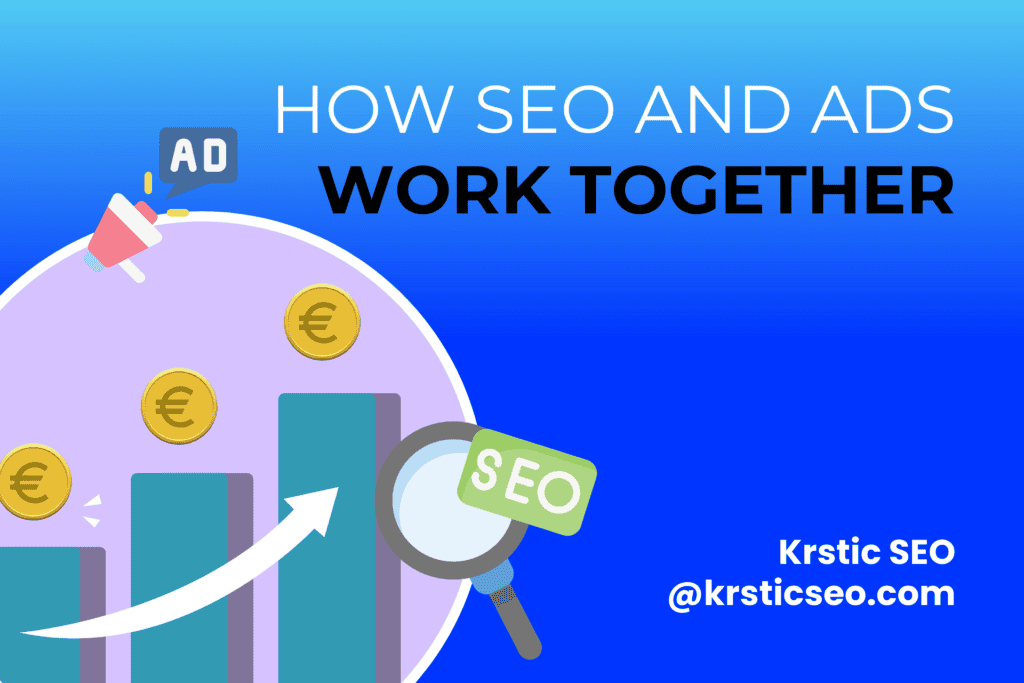
~7 Minute Read
Quick Answer
By properly applying some of the basic on-page SEO strategies to your Google Ads PPC landing page, you can actually decrease your Google Ads costs. In return, running Google Ads to your website helps bring new users and their engagement, sending positive signals to Google that the website is interactive and helpful, thus lifting its SEO rankings.
Do SEO and Google Ads Work Together?
This headline above I added simply due to SEO purposes (so that this article too would rank on Google, hehe :D).
The proper question would be – can you make more money by utilizing both SEO and Google Ads at the same time?
And if yes, how?
And yes, the answer is yes. Running Google Ads PPC campaigns, LSAs (Local Search Ads), and SEO at the same time increases your odds of winning every single customer from Google search you can get by a lot.
We’ll now apply some simple math to help you figure out how this is.
SEO and Google Ads Together Help You Get More Customers
I’ll reference the overly-utilized article by First Page Sage on this topic (I referenced it likely dozens of times on this website already), but here it really comes in handy.
Their study says:
- The number-one website result gets 20–25% of all clicks
- Each Google Business Profile, AKA Google Maps result, gets 15–20% of all clicks (close to 50% combined)
When it comes to Google Ads:
- Text ads get approximately 6% of all traffic on search results
- Whereas, Local Services Ads get approximately 9%
The rest is spread across other websites in top positions, like Yelp, Angi’s, and Thumbtack. Click through percentages fall off the cliff for websites in positions #3 and lower.
So, unless you fall in between some of these enclaves on the first page of Google results (usually called SEPRs in the SEO industry), you’ll get no customers.
But why would I care about a 6% chance of a click with Google Ads?!
Well, because some industries have A LOT of demand on Google search.
Take mold removal in Miami, for example.
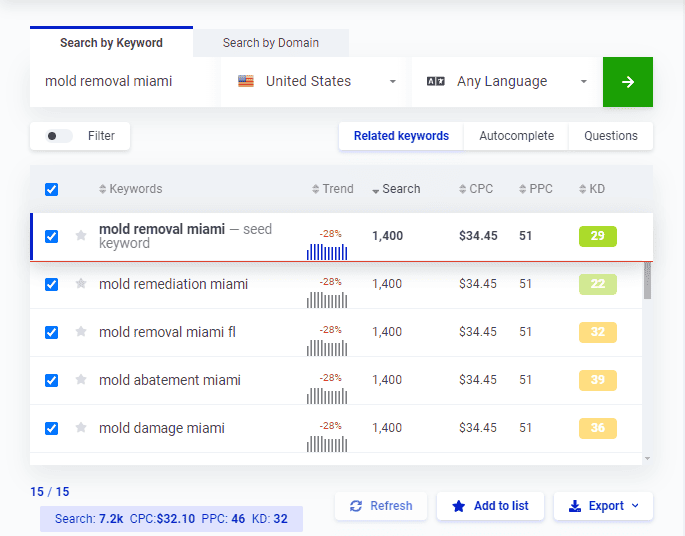
That’s over 7,000 monthly searches for mold removal in Miami on Google.
Google Ads 6% of that is around 420 potential customers you’re looking at.
Each mold removal job could be worth multiple 4 figures for a company that handles it, so now you start to see how valuable just those 6% could be.
When running ads AND doing SEO successfully, you’re basically playing monopoly on Google search.
Who wins the monopoly game? The guy/girl with the most red hotels.
Ready to start building your own red hotels? Here are some tips for winning the game.
How SEO Helps Google Ads
Inside Google Ads, there’s thing called the “Quality Score.”
It’s used as a measurement by Google in order to determine, well, how good of a quality your ads are.
The higher the quality score, the less you’ll have to bid to win the same customer, in essence.
Bid, you say?
You see, Google Ads run like an auction. The only difference is that the highest bidder doesn’t always win.
The one who wins (ranks the highest on Google Ads results and wins the most customers) is the guy with the high enough bid and a high enough quality score.
Now, since this is a topic big enough for its own separate blog (perhaps even several), just know this: one of the big aspects of determining a particular ad’s quality score is relevance.
Keywords in the ad help determine how relevant an ad is to a particular search query, but only partially. Another component is keywords on the Google Ads PPC landing page.
PPC landing pages, in order to generate the biggest number of leads as possible, should be properly optimized for conversions. This is typically done by adding social proof, portfolio, reviews, and other things.
And while this should always be done, by applying some basic on-page SEO to your PPC landing page without sacrificing the conversationality of the page, you can help boost that quality score.
A higher quality score means you’ll have to bid less to rank the highest with your ad.
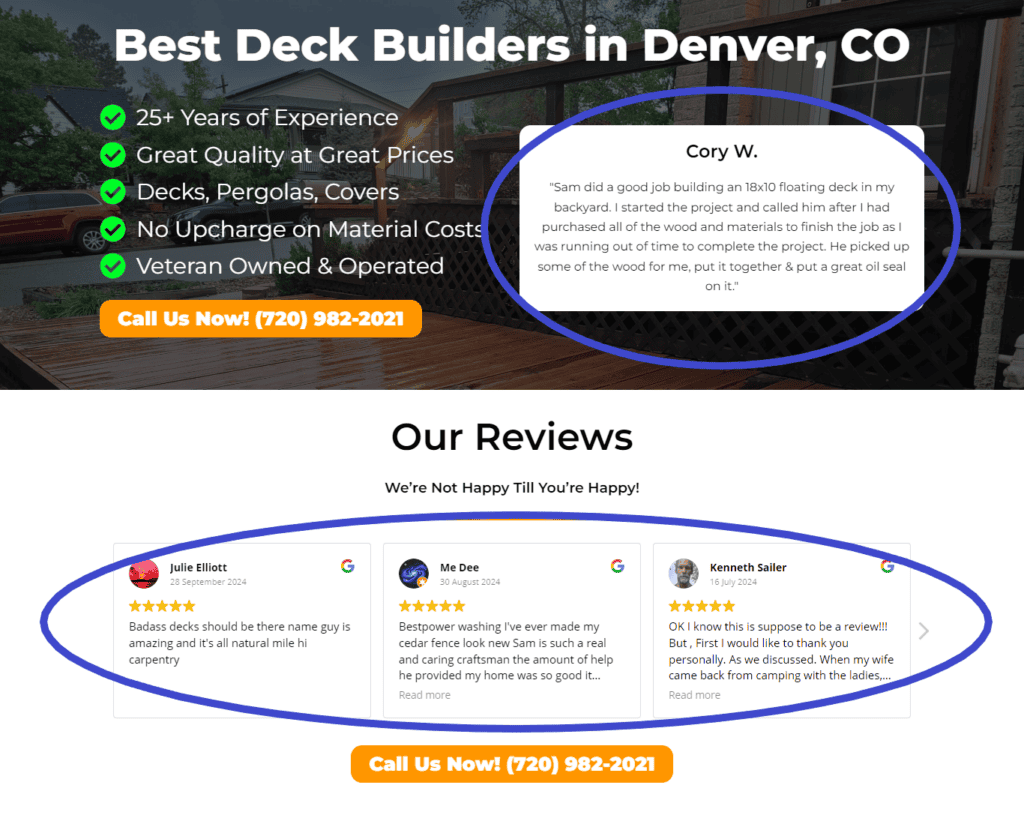
How Google Ads Help SEO
Let’s flip the switch now—how do Google Ads help SEO?
Google Ads can bring clicks to your website instantly, there’s no denying that. SEO, no matter how well done, takes at least a few weeks to start bringing some clicks and leads.
That is not the case with Google Ads.
Now, whether or not these clicks result in the phone ringing, that’s another story. Typically, the phone doesn’t start ringing overnight, even with Google Ads.
You might not know that traffic in and of itself is a ranking factor for SEO.
Traffic as a Ranking Factor for SEO
Yup, that’s right.
What type of traffic?
Well, any, as long as it’s real:
- Social
- Referral
- Direct
- And, of course, organic traffic—traffic we get from SEO
Why is traffic a ranking signal?
Note, just getting your family and friends to click on your website over and over won’t help you rank. That’s not what I meant.
The way traffic helps your website rank better with SEO is by sending positive user signals to Google from your website.
If your website is interactive and helpful, new users will stick around, check out what you have to offer by browsing multiple pages and posts you have published, click, scroll, and in the end either complete an action you want (call a phone number or fill out a lead form) or leave.
Google tracks all of these actions to understand user behavior and how “valuable” your website is. Sending Google Ads traffic to your website helps speed this up since you don’t have to wait for as much organic traffic to start coming in months or even years later.
Additionally, traffic from other sources of the web other than SEO helps confirm the existence of a real brand, which Google has put a lot of weight on the last few years.
Running ads both on Google and other platforms may prompt some users to look up your business’s about page, Google Business Profile and its reviews, and other related content about your brand, which further signals to Google that a lot of people recognize your business.
Things can get really complicated here, but just know, by running Google Ads, you could speed up your SEO.
Doing Google Ads and SEO Together - Tips
Now that you know how SEO and Google Ads work together and have each other’s backs, it’s time for some tips on how to get the best results.
SEO - Apply CRO To Each Page, As You Would With PPC
“Conversion rate optimization” refers to those principles we’ve mentioned earlier about how to make your Google Ads landing pages perform as best as possible.
Our first tip would be to apply those same principles to all landing pages you’re trying to rank with SEO as well in order to get the most leads possible once organic traffic starts coming in.
This includes a few steps:
1. Above-the-Fold Content Optimization
“Above the fold” simply means what users see right away upon landing on a page, without scrolling.
So, knowing this, make sure to have:
- Impactful headline combining both problem and solution—example: “Increase Home Value and Lower Energy Bills With Our Solar Panels!”
- Customer testimonial/social proof
- Clear call-to-action (CTA)
All clearly visible before a user scrolls.
💡 Expert Insight - Thomas Frood, Google Ads Specialist
"The headline is the most important section of any landing page. David Ogilvy, known as the 'Father of Advertising,' said, 'On average, five times as many people read the headline as read the body copy. When you have written your headline, you have spent eighty cents out of your dollar.' This shows how important the content above the fold is. Ensuring this section is clear with a strong headline, social proof, and compelling call-to-action can significantly boost engagement and conversions, ultimately turning traffic into real results."
2. Credibility Indicators
You may have noticed that we utilize “As Seen In” sections featuring media appearances on pretty much all of our landing pages here at Krstic SEO.
Well, there’s a reason for that. Actually, multiple:
- Enhancing credibility
- Building trust
- Establishing authority in our field
Many people in business will likely recognize some of the platforms we’re featured on, which signals that we’re an authority in our field.
Don’t have those for your own website? Seek media coverage through platforms like HARO. More on that in our link building guide.
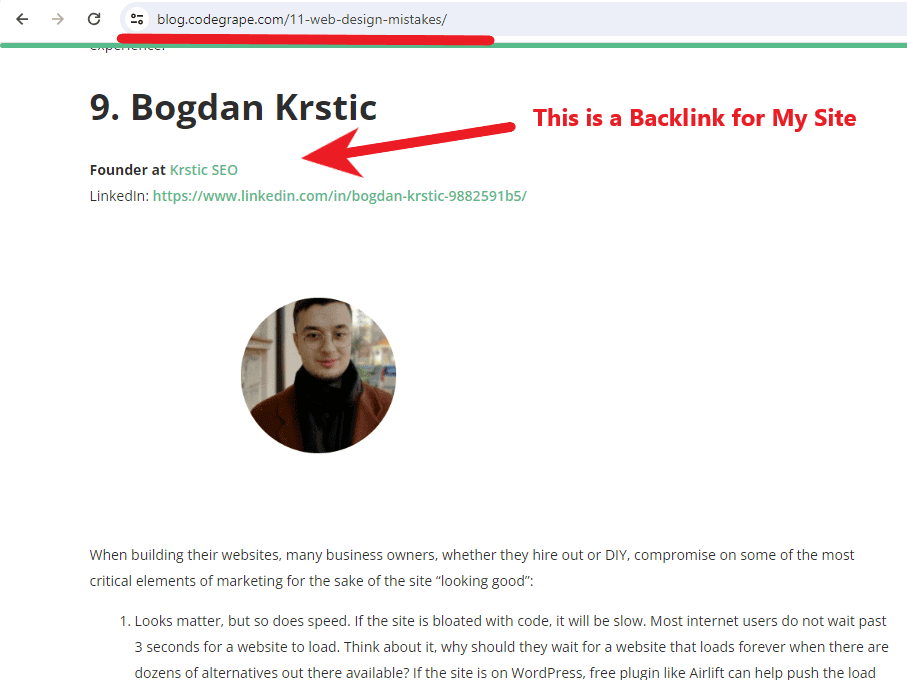
3. Social Proof
We’ve mentioned putting social proof above the fold. Keep utilizing social proof throughout the rest of the page too.
Distribute different testimonials (ideally have one or more video testimonials) throughout the page after each couple of paragraphs of text.
4. Keep The Content Easily Digestible
Your landing pages differ from your blog posts and educational articles.
They have the purpose of selling, not making someone qualified for a PhD.
So, make your content easily digestible and deliver only the most important points first.
Incorporate visual elements like images and videos. After each content block, use a CTA.
5. One primary CTA Per Page
Keep your pages having only ONE main goal you want the users to complete (a phone call, a quote form submission, or a purchase).
Having two or more of these goals decreases conversions.
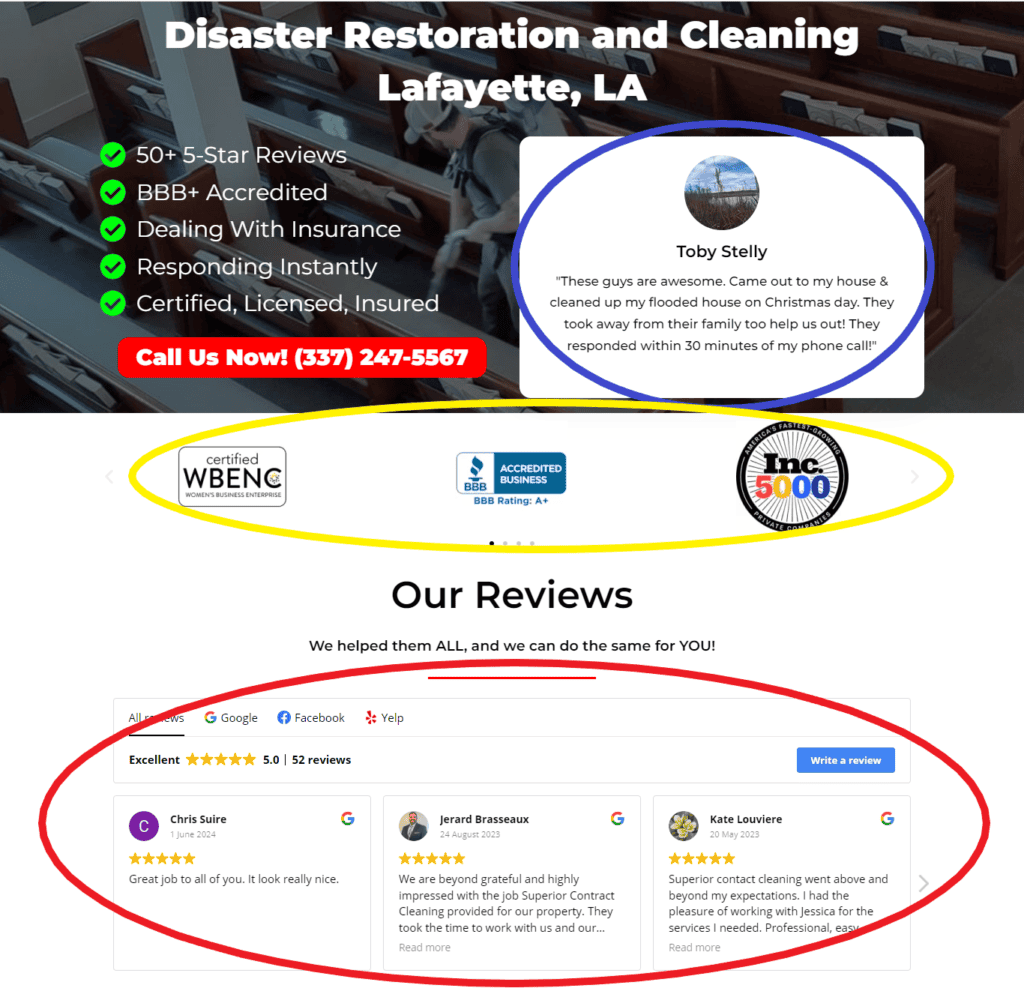
Google Ads - Keep PPC Landing Pages Separate
The pages you’ll actually send Google Ads traffic to should be completely separated from the rest of the website.
This dramatically increases the conversion rate of your landing pages, decreasing your cost per lead on Google Ads and improving your quality score.
1. Don’t Use a Homepage for Google Ads
Using a homepage for Google Ads is one of the most common mistakes business owners do.
Simply put, a homepage is not meant for Google Ads. It has too many distractions.
Your gallery, your services, your company’s about story, and so on, whereas Google Ads landing pages have no distractions like that.
They’re presenting an offer for only one product/service to one type of an audience.
2. Don’t Have Navigation on a Landing Page
Hide your header and footer from your Google Ads landing page.
You don’t want your Google Ads traffic to click around on your website.
Instead, they should only be able to complete ONE action on your landing page—call you, fill out a form, or complete a purchase.
Besides these two tips, apply the rest of the aforementioned ones too and your chances of running a successful Google Ads campaign will skyrocket.
Wrapping Up
This brings us to the end of this post.
It was a bit lengthy, but hopefully, helpful enough to you.
Want to learn more about SEO? Check out some of our other articles:
Need more help?
If you have an existing website you’d like to be SEO-ed and bring more sales for your company, get our free SEO audit!

Bogdan is a local SEO expert with over 3 years of experience helping businesses grow using Google. When he is not helping businesses grow, he works on his own SEO projects, works out, takes long walks, and watches Suits, which is completely ironic given how rarely he dresses up in a suit himself.
